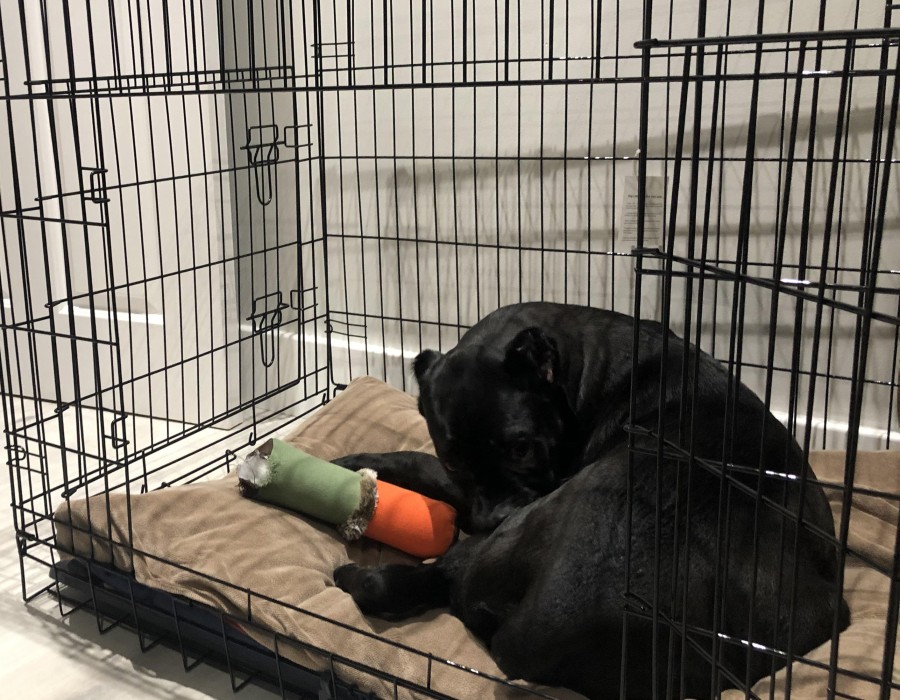House training a Cane Corso can be a rewarding yet challenging journey, especially for new owners of this powerful and intelligent breed. A structured approach is necessary to guide them toward good habits and reliable bathroom routines. One effective method many owners use is crate training, which provides both structure and comfort for the dog. In fact, using a crate for Cane Corso house training can significantly speed up the process by leveraging the dog’s natural instincts for cleanliness and routine.
Why Crate Training Works for Cane Corsos
Cane Corsos, like many dogs, prefer not to soil their sleeping area. A crate naturally encourages them to hold their bladder and wait until they are taken outside.
Natural Instincts and Clean Habits
Dogs are den animals by nature. The crate mimics the feeling of a den, offering security while promoting cleanliness. This makes crate training one of the most effective house training tools.
Providing Security and Comfort
For a Cane Corso, the crate becomes a personal space where they feel safe. This sense of security not only helps with training but also reduces anxiety in new or stressful situations.
Supporting Structure and Routine
Cane Corsos thrive when given consistent routines. Crate training introduces predictability, helping puppies understand when it’s time to rest, play, or go outside.

Choosing the Right Crate for Cane Corso
The effectiveness of crate training largely depends on selecting the correct crate.
Size Matters
A Cane Corso is a large breed, so the crate should be spacious enough for them to stand, turn around, and lie comfortably. However, it should not be so big that the dog can use one side as a bathroom and the other for sleeping.
Durable Construction
Given the strength of Cane Corsos, a sturdy crate is essential. High-quality metal or reinforced plastic crates are typically recommended to withstand their power.
Comfort and Accessories
Adding soft bedding and safe chew toys makes the crate more inviting. However, during the early training stages, avoid bedding that can be easily soiled or shredded.
Steps for Effective Crate Training
Proper introduction and consistent use are key to making crate training successful.
Gradual Introduction
Start by letting the Cane Corso explore the crate with the door open. Encourage them to enter voluntarily using treats or toys, building positive associations from the start.
Feeding in the Crate
Feeding your dog inside the crate helps establish it as a safe and rewarding place. Over time, this routine reinforces the idea that the crate is their personal den.
Setting a Bathroom Routine
Immediately after crate time, take your Cane Corso outside to relieve themselves. Consistently linking crate use with outdoor bathroom breaks creates a strong routine.
Avoiding Overuse
While crates are useful, they should not be used for extended periods. Overusing the crate can lead to frustration and may hinder house training progress.
Common Challenges With Crate Training
Even with the right approach, owners may encounter some obstacles during the process.
Whining or Barking
Some puppies cry when first introduced to the crate. The key is not to let them out immediately, as this reinforces negative behaviour. Instead, wait for a calm moment before opening the door.
Accidents Inside the Crate
Accidents can happen, especially in younger puppies. If this occurs, reassess crate size, feeding schedules, and bathroom routines to identify the cause.
Resistance to Entering
If the Cane Corso resists entering the crate, avoid forcing them. Instead, use treats, praise, or toys to create a positive connection. Patience will yield better results.
Benefits of Crate Training for Housebreaking
When used correctly, crate training provides lasting benefits for house training and beyond.
- Faster Learning Curve: Cane Corsos quickly learn to associate crate time with bathroom breaks, accelerating the overall house training process.
- Building Discipline: The crate helps establish boundaries and routines, shaping good behaviour both indoors and outdoors.
- Easier Transition Into Adulthood: Once trained, adult Cane Corsos often view their crate as a sanctuary. This makes travel, veterinary visits, and household management more manageable.
Beyond House Training: Additional Uses of a Crate
While house training is a primary goal, crates serve other purposes throughout a Cane Corso’s life.
Travel Safety
A crate ensures safety during car rides, preventing distractions for the driver and protecting the dog in case of sudden stops.
Recovery After Illness or Surgery
When rest is necessary, crates provide a controlled environment that supports recovery.
Managing Separation Anxiety
The crate offers comfort when owners are away, reducing destructive behaviours caused by stress or boredom.

Conclusion
Using a crate for Cane Corso house training is one of the most effective strategies for building discipline, promoting cleanliness, and speeding up the learning process. By tapping into the breed’s natural instincts for security and routine, crate training creates a positive environment where both owner and dog can thrive. Success depends on choosing the right crate, introducing it properly, and using it consistently without over-reliance. With patience, structure, and positive reinforcement, crate training not only improves house training but also enhances the Cane Corso’s overall quality of life.
FAQs
How big should a crate for Cane Corso be?
It should be large enough for the dog to stand, turn, and lie comfortably, but not oversized to the point where accidents may occur.
Can crate training be used for adult Cane Corsos?
Yes, crate training can be introduced at any age, though puppies often adapt more quickly.
How long can a Cane Corso stay in a crate?
Puppies should not stay in a crate for more than 2–4 hours at a time. Adults may handle longer periods but should not exceed 6–8 hours.
Will crate training stop my Cane Corso from having accidents indoors?
Yes, with consistency, crate training teaches them to hold their bladder until taken outside, reducing indoor accidents.
Is crate training cruel for Cane Corsos?
No, when done correctly, crate training provides comfort and security, making it a safe and beneficial tool.





Comments